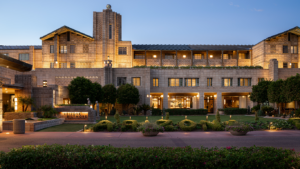For the extreme heat of the desert Southwest, where temperatures are reaching 110°F and higher this summer, can transit-oriented development improve the quality of life?
The answer is yes. Through collaborations on several new projects, the Phoenix-based firm Studio Ma — a specialist in environmental design and architecture — has shown how to cool streets with natural shade and building overhangs, enhance pedestrian experience, and even make streets more attractive and usable.
The work on transit-oriented developments (TODs) also show promise for increasing ridership on buses and the Valley Metro Light Rail line. Of great interest to local officials, TODs are seens as techniques for Phoenix to continue its smart-growth and environmental conservation policies.
HOW TO COOL COMMUTERS
To make the hottest and driest regions in North America more habitable and walkable, Studio Ma’s architects employ a combination of shading, evaporative cooling and enhanced air movement. Recent projects by Studio Ma to create TODs and boost transit use include:

Downtown Phoenix Zoning Code and Masterplan: On a team led by Dyett and Bhatia Planners, Studio Ma helped create a 2.15-square-mile “Green Grid” network of shaded streets and transit stops which, combined with better building shapes and street profiles — plus a designated material palette — enhances pedestrian comfort while reducing the urban heat-island effect.
Apache and Oak, Tempe: For this mixed-use housing project, Studio Ma designed a new five-story building with an “activated streetscape” including outdoor dining, casual seating, and a mews that draws pedestrians into the shaded, protected interior court. With overhangs for shade and extensive landscaping, the TOD reduces urban heat-island effect and makes pedestrian and outdoor life more comfortable. The modern building’s materials cool people too, with concrete masonry, insulated synthetic stucco, glass and wood plank.
PRD 845, Phoenix: An acclaimed prototype, this modest housing development has a mews layout, which opens the property to breezes and shade for active, live-work lifestyles. Ground-floor garages and studio spaces, plus large outdoor roof decks with views of downtown Phoenix and the surrounding mountains, attract buyers. As a TOD, it’s within walking distance of the Valley Metro Light Rail line, making PRD 845 a transitional housing type — unlike a dense multifamily block, and more effective for TODs than single-family dwellings downtown.

“Each project responds to unique, local conditions, but a number of general TOD planning principles have been used throughout,” says Jason Boyer, AIA, LEED AP, an architect and specialist in urban housing and TODs with Studio Ma. “The keys include a better street experience, proximity to transit options, a more walkable livable outdoors, and a mix of uses that make people want to come and stay.”
The results are ideal for creating an oasis in the contemporary desert city. Among the key principles Boyer lists for Studio Ma’s highly effective TODs in the desert region include:
– An activated, pedestrian-oriented ground plane
– Human-scaled building massing to enhance street corridors
– Incorporation of architectural and natural shade
– Urban heat island mitigation
– Multi-use programming



